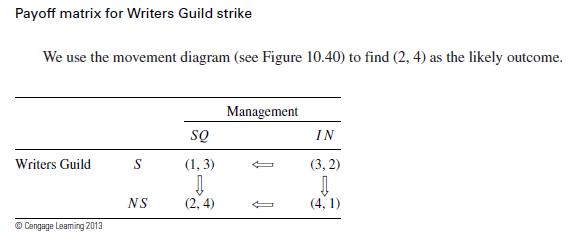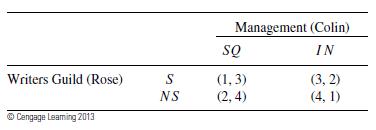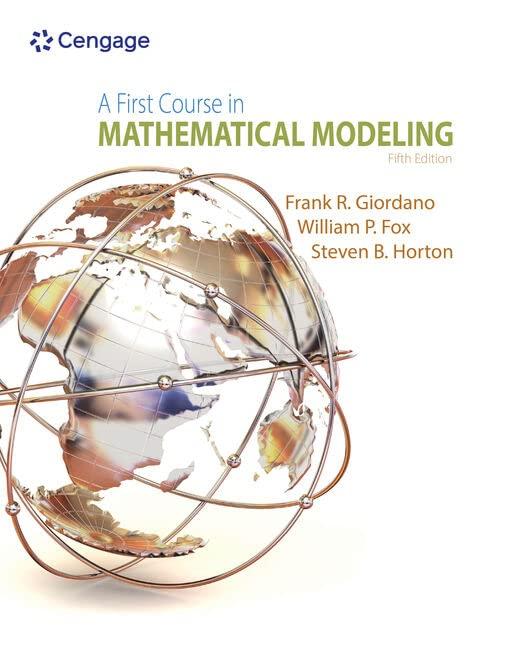From the Further Reading, on Nash arbitration. The mathematics of Nash arbitration is to find Point N
Question:
From the Further Reading, on Nash arbitration. The mathematics of Nash arbitration is to find Point N inside the convex payoff polygon that maximizes (x– x∗) (y– y∗) subject to x≥x∗y≥y∗ where (x; y) is known as the status quo point. Apply the Nash arbitration scheme to the Writer Guild problem assuming the payoffs are interval scale values, Example 5, to show that when the status quo point is (2, 3) that the Nash arbitration solution is (2.3333, 3.5).
Data from example 5
The 2007–2008 Writers Guild of America strike was a strike by the Writers Guild of America, East (WGAE) and the Writers Guild of America, West (WGAW) that started on November 5, 2007. The WGAE and WGAW were two labor unions representing film, television, and radio writers working in the United States. Over 12,000 writers joined the strike. These entities will be referred to in the model as the Writers Guild. The strike was against the Alliance of Motion Picture and Television Producers
(AMPTP), a trade organization representing the interests of 397 American film and television producers. The most influential of these are eight corporations: CBS Corporation, Metro-Goldwyn-Mayer, NBC Universal, News Corp/Fox, Paramount Pictures, Sony Pictures Entertainment, the Walt Disney Company, and Warner Brothers. We refer to this group as Management. The Writers Guild indicated their industrial action would be a ``marathon.'' AMPTP negotiator Nick Counter indicated negotiations would not resume as long as strike action continued, stating, ``We're not going to negotiate with a gun to our heads that's just stupid. 'The last such strike in 1988 lasted 21 weeks and 6 days, costing the American entertainment industry an estimated $500 million ($870 million in 2007 dollars). According toa report on the January 13, 2008, edition of NBC Nightly News, if one takes into account everyone affected by the current strike, the strike had cost the industry $1 billion so far; thesis a combination of lost wages to cast and crew members of television and film productions and payments for services provided by janitorial services, caterers, prop and costume rental companies, and the like.
The TV and movie companies stockpiled ``output'' so that they could possibly outlast the strike rather than work to meet the demands of the writers and avoid the strike.
Game Theory Approach:
Let us begin by stating strategies for each side. Our two rational players will be the Writers
Guild and Management. We develop strategies for each player.
Strategies:
•Writers Guild: Its strategies are to strike (S) or not to strike (NS).
•Management: Its strategies are salary increase and revenue sharing (IN) or status quo
(SQ).
First, we rank order the outcomes for each side in order of preference. (These rank
orderings are ordinal utilities.)
Writer's Alternatives and Rankings:
•Strike-status quo S SQ: writers' worst case (1)
•No strike-status quo NS SQ: writers' next-to-worst case (2)
•Strike-salary increase and revenue sharing S IN: writers' next-to-best case (3)
• No strike-salary increase and revenue sharing NS IN: writers' best case (4)
Management's Alternatives and Rankings:
• Strike-status quo: Management's next-to-best case (3)
• No strike-status quo: Management's best case (4)
• Strike-salary increase and revenue sharing: Management's next-to-worst case (2)
• No strike-salary increase and revenue sharing: Management's worst case (1)
This provides us with a payoff matrix consisting of ordinal values (see Figure 10.39).
We will refer to the Writers Guild as Rose and Management as Colin.
Figure 10.39


We use the movement diagram (see Figure 10.40) to find (2, 4) as the likely outcome.
We notice that the movement arrows point toward (2, 4) as the pure Nash equilibrium. We also note that this result is not satisfying to the Writers Guild, and that it would like to have a better outcome. Both (3, 2) and (4, 1) within the payoff matrix provide better outcomes to the Writers Guild. We can employ several options to try to secure a better outcome for the Writers Guild.
We can first try strategic moves, and if that fails to produce a better outcome then we can move on to Nash arbitration. Both of these methods employ communications in the game. In strategic moves, we examine the game to see if ``moving first'' changes the outcome, if threatening our opponent changes the outcome, if making promises to our opponent changes our outcome, or if a combination of threats and promises is needed to change the outcome. We examine strategic moves. The Writers Guild moves first, and its best result is again (2, 4). If management moves first, the best result is (2, 4). First moves keep us at the Nash equilibrium. The Writers Guild considers a threat and tells Management that if it chooses SQ that it will strike, putting the players at (1, 3). This result is indeed a threat as it is worse for both the Writers Guild and Management. However, the options for Management under IN are both worse than (1, 3), so Management does not accept the threat. The guild does not have a promise. At this point, we might involve an arbiter.
Step by Step Answer:

A First Course In Mathematical Modeling
ISBN: 9781285050904
5th Edition
Authors: Frank R. Giordano, William P. Fox, Steven B. Horton





